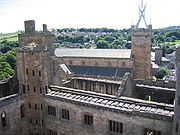
St. Michael's Parish Church, Linlithgow
Encyclopedia


Burgh
A burgh was an autonomous corporate entity in Scotland and Northern England, usually a town. This type of administrative division existed from the 12th century, when King David I created the first royal burghs. Burgh status was broadly analogous to borough status, found in the rest of the United...
churches in the Church of Scotland
Church of Scotland
The Church of Scotland, known informally by its Scots language name, the Kirk, is a Presbyterian church, decisively shaped by the Scottish Reformation....
. It is one of two parishes serving the West Lothian
West Lothian
West Lothian is one of the 32 unitary council areas in Scotland, and a Lieutenancy area. It borders the City of Edinburgh, Falkirk, North Lanarkshire, the Scottish Borders and South Lanarkshire....
county town of Linlithgow
Linlithgow
Linlithgow is a Royal Burgh in West Lothian, Scotland. An ancient town, it lies south of its two most prominent landmarks: Linlithgow Palace and Linlithgow Loch, and north of the Union Canal....
, the other being St. Ninian's Craigmailen. St Michael is the town's patron saint; the town's motto is "St Michael is kinde to strangers".
King David I of Scotland granted a charter for the establishment of the church in 1138. The church was built on the site of an older church and was consecrated in 1242. Following a fire in 1424, most of the present building dates from the mid 15th century, with extensive restorations in the 19th century. Parts of the Church of St Michael were brought into use as they were completed, and the church was completed in 1540.
Built immediately to the south of Linlithgow Palace
Linlithgow Palace
The ruins of Linlithgow Palace are situated in the town of Linlithgow, West Lothian, Scotland, west of Edinburgh. The palace was one of the principal residences of the monarchs of Scotland in the 15th and 16th centuries. Although maintained after Scotland's monarchs left for England in 1603, the...
, the church was much favoured as a place of worship by Scottish Kings and Queens. Mary, Queen of Scots, was born in Linlithgow Palace on 8 December 1542 and was baptised in St Michael’s Church.
In 1559, at an early stage of the Scottish Reformation
Scottish Reformation
The Scottish Reformation was Scotland's formal break with the Papacy in 1560, and the events surrounding this. It was part of the wider European Protestant Reformation; and in Scotland's case culminated ecclesiastically in the re-establishment of the church along Reformed lines, and politically in...
, the Protestant Lords of the Congregation
Lords of the Congregation
The Lords of the Congregation were a group of Protestant Scottish nobles who in the mid-16th century favoured reformation of the church along Protestant principles and a Scottish-English alliance.- Historical events :...
destroyed the statues adorning the exterior and interior of the church as signs of "popishness", and defaced the statue of St Michael which formed part of the structure.
Following the Reformation, the interior of the church was reordered. Some traces of pre-Reformation artefacts can still be detected. In 1646, Oliver Cromwell
Oliver Cromwell
Oliver Cromwell was an English military and political leader who overthrew the English monarchy and temporarily turned England into a republican Commonwealth, and served as Lord Protector of England, Scotland, and Ireland....
's troops stabled their horses within the nave. Following the departure of the troops considerable restoration was required.
By the early 19th century the church was in a very poor physical condition. Although repairs were made, many of the historic features of the church were destroyed, the interior walls were whitewashed, a plaster ceiling replaced a fine 16th century one and in 1821 the stone Crown Tower ( a crown steeple
Crown steeple
A crown steeple, or crown spire, is a traditional form of church steeple in which curved stone flying buttresses form the open shape of a rounded crown...
similar to that of St Giles' Cathedral) had to be dismantled. While other repairs were completed and the church was rededicated in 1896, the tower was too weakened for restoration of the original crown steeple.
By the late 19th century tastes had changed radically, with the installation of the church's first post-Reformation stained glass windows. In 1964, in a then highly controversial move, an aluminium crown was installed (replacing the Crown Tower removed in 1821). The modern crown is evocative of Christ's crown of thorns; it is intended to emphasise the kingship of Christ over his church. The lightweight aluminium minimises the load on the tower and reinterprets the crown steeple in a modern idiom.
The church has been served by some notable former ministers, including the Very Revd Dr David Steel
David Steel (Church of Scotland minister)
David Steel was a Church of Scotland minister.From 1949 to 1957 he was minister of St Andrew's Church, Nairobi, Kenya...
(father of the politician David Steel
David Steel
David Martin Scott Steel, Baron Steel of Aikwood, KT, KBE, PC is a British Liberal Democrat politician who served as the Leader of the Liberal Party from 1976 until its merger with the Social Democratic Party in 1988 to form the Liberal Democrats...
) who was Moderator of the General Assembly of the Church of Scotland
Moderator of the General Assembly of the Church of Scotland
The Moderator of the General Assembly of Church of Scotland is a Minister, Elder or Deacon of the Church of Scotland chosen to "moderate" the annual General Assembly of the Church of Scotland, which is held for a week in Edinburgh every May....
in 1974. The current minister is the Revd Dr Stewart Gillan.

